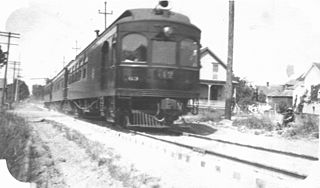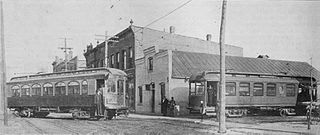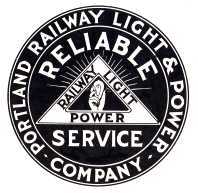
The interurban is a type of electric railway, with tram-like electric self-propelled railcars which run within and between cities or towns. The term "interurban" is usually used in North America, with other terms used outside it. They were very prevalent in many parts of the world before the Second World War and were used primarily for passenger travel between cities and their surrounding suburban and rural communities. Interurban as a term encompassed the companies, their infrastructure, their cars that ran on the rails, and their service. In the United States, the early 1900s interurban was a valuable economic institution, when most roads between towns, many town streets were unpaved, and transportation and haulage was by horse-drawn carriages and carts.

The Oregon Electric Railway (OE) was an interurban railroad line in the U.S. state of Oregon that linked Portland to Eugene.

The Illinois Terminal Railroad Company, known as the Illinois Traction System until 1937, was a heavy duty interurban electric railroad with extensive passenger and freight business in central and southern Illinois from 1896 to 1956. When Depression era Illinois Traction was in financial distress and had to reorganize, the Illinois Terminal name was adopted to reflect the line's primary money making role as a freight interchange link to major steam railroads at its terminal ends, Peoria, Danville, and St. Louis. Interurban passenger service slowly was reduced, ending in 1956. Freight operation continued but was hobbled by tight street running in some towns requiring very sharp radius turns. In 1956, ITC was absorbed by a consortium of connecting railroads.

The Modesto and Empire Traction Company is a Class III short-line railroad operating in California's San Joaquin Valley. It is owned by the Beard Land & Investment Company; the Beard family has always owned the railroad. The Beards also created the Beard Industrial Park where the MET's customers are located. The railroad was unique in that it had operated for nearly 50 years exclusively with GE 70-ton switchers built between 1947 and 1955; however, a former Southern Pacific EMD SW1500 switcher was added to the roster as of late. The MET operates on 5 miles (8 km) of mainline track, as well as an additional 48.7 miles (78.4 km) of yard and industry track, providing switching services in the Beard Industrial Park. The MET interchanges with the Union Pacific at Modesto and with the BNSF Railway Stockton Subdivision at Empire.

The Sacramento Northern Railway was a 183-mile (295 km) electric interurban railway that connected Chico in northern California with Oakland via the state capital, Sacramento. In its operation it ran directly on the streets of Oakland, Sacramento, Yuba City, Chico, and Woodland. This involved multiple car trains making sharp turns at street corners and obeying traffic signals. Once in open country, SN's passenger trains ran at fairly fast speeds. With its shorter route and lower fares, the SN provided strong competition to the Southern Pacific and Western Pacific Railroad for passenger business and freight business between those two cities. North of Sacramento, both passenger and freight business was less due to the small town agricultural nature of the region and due to competition from the paralleling Southern Pacific Railroad.

The Elgin and Belvidere Electric Company was a 36-mile (58 km) interurban line that connected Belvidere, Illinois and Elgin, Illinois. It was the central link in the interurban network connecting Freeport, Rockford, Elgin, and Chicago which included the Rockford and Interurban Railway to the west and the Chicago, Aurora and Elgin Railroad to the east. The line was operational from 1907 until 1930. In 1927, the line was extended to Rockford over a line of the Rockford and Interurban.
The Youngstown and Ohio River Railroad, or Y&OR, was one of the smaller interurban railways in the state of Ohio. Along with the Youngstown and Southern Railway, the Y&OR formed a traction link between Youngstown, Ohio and the Ohio River at East Liverpool. It served several coal mines in the area and it was distinguished by the unusual feat of electrifying a section of a steam railroad, the Pittsburgh, Lisbon and Western Railroad, as part of a trackage rights agreement. The Y&OR operated for 24 years.

The Visalia Electric Railroad, a wholly owned subsidiary of the Southern Pacific Railroad (SP), began as an electric interurban railroad in Tulare County, in the U.S. State of California. The railroad was incorporated on April 22, 1904. Passenger service was discontinued in 1924, and the electrification was removed in 1944. Subsequent operation was by diesel locomotive. The railroad was closed in 1992.

The Detroit United Railway was a transport company which operated numerous streetcar and interurban lines in southeast Michigan. Although many of the lines were originally built by different companies, they were consolidated under the control of the Everett-Moore syndicate, a Cleveland-based group of investors. The company incorporated on December 31, 1900, and continued to expand into the early 1920s through new construction and the acquisition of smaller concerns. After the DUR acquired the Detroit-Jackson line in 1907, it operated more than 400 miles (640 km) of interurban lines and 187 miles (301 km) of street city street railway lines.

West Penn Railways, one part of the West Penn System, was an interurban electric railway headquartered in Connellsville, Pennsylvania. It was part of the region's power generation utility.

The Upland–San Bernardino Line was an interurban line operated by the Pacific Electric Railway between Downtown Los Angeles and San Bernardino, California. This line also had shorter service that terminated before the end of the line at Baldwin Park, Covina, and San Dimas. Though service along this line in its entirety was discontinued in November 1941, it stands as the fourth-longest rapid transit line in American history, after the Sacramento Northern Railway's Chico and Colusa services, and the Pacific Electric's own Riverside–Rialto Line.

The Portland Railway, Light and Power Company (PRL&P) was a railway company and electric power utility in Portland, Oregon, United States, from 1906 until 1924.

The Southern Pacific Red Electric Lines, also known simply as the Red Electric, was a network of interurban passenger train services operated by the Southern Pacific Railroad in the Willamette Valley of the U.S. state of Oregon from 1914 to 1929. The service got its name from the bright red color of its cars. Despite its short history, among West Coast interurbans it was unique, and it was considered the finest such system in the Pacific Northwest. It was the only major electric interurban railroad converted from steam to electric passenger use. It was also one of few systems using all-steel equipment, and one of the largest 1500-volt systems in the country.

The Portland Railway, Light and Power Sellwood Division Carbarn Office and Clubhouse, also known as Carmen's Clubhouse, in southeast Portland in the U.S. state of Oregon, is a former commercial transportation building listed on the National Register of Historic Places (NRHP). Built in 1910 by the Portland Railway, Light and Power Company (PRL&P), it was added to the register in 2002. The structure was associated with Portland's street railway and interurban system of the late 19th and early 20th centuries.

The West Ankeny Car Barns Bay E is a former streetcar carbarn in Portland, Oregon, that is listed on the U.S. National Register of Historic Places. Completed in 1911, it was one of three buildings that collectively made up the Ankeny Car Barns complex of the Portland Railway, Light and Power Company (PRL&P), the owner and operator of Portland's streetcar system at the time. By 1978, the brick building had become the only surviving structure from the Ankeny complex and one of only two surviving remnants of carbarn complexes of the Portland area's large street railway and interurban system of the past, the other being the PRL&P's Sellwood Division Carbarn Office and Clubhouse.

The Forest Grove branch is an abandoned railway line in the state of Oregon, in the United States. It was built by the Oregon Electric Railway and ran 19.1 miles (30.7 km) from Garden Home to Forest Grove via Beaverton and Hillsboro. The MAX Blue Line uses part of the right-of-way between Beaverton and Hillsboro.
The Newberg branch is a railway line in the state of Oregon, in the United States. It runs 36 miles (58 km) from Portland to a junction with the West Side branch west of Saint Joseph. It was originally built by the Portland and Willamette Valley Railway, a predecessor of the Southern Pacific Transportation Company.
The Tigard branch is a short railway line on the west side of Portland, Oregon, in the United States. It connects the Union Pacific Railroad's West Side branch and Newberg branch. It was originally built in 1910 by the Beaverton and Willsburg Railroad, a subsidiary of the Southern Pacific Transportation Company. The Portland and Western Railroad operates the line, including the WES Commuter Rail service.
United Railways was a railroad in Oregon. Begun as an electric interurban railway in 1911, passenger service was never effective and the road became a freight link to the Tualatin Valley. The company was dissolved in 1944, but the railroad line remains active.















